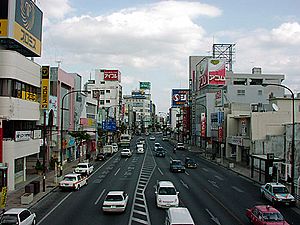Okinawa (city) facts for kids
Quick facts for kids
Okinawa City
沖縄市
Uchinaa
|
|||
|---|---|---|---|

Okinawa City Hall
|
|||
|
|||

Location of Okinawa in Okinawa Prefecture
|
|||
| Country | Japan | ||
| Region | Kyushu | ||
| Prefecture | Okinawa Prefecture | ||
| Area | |||
| • Total | 49.00 km2 (18.92 sq mi) | ||
| Population
(October 1, 2020)
|
|||
| • Total | 142,752 | ||
| • Density | 2,913.31/km2 (7,545.4/sq mi) | ||
| Time zone | UTC+9 (Japan Standard Time) | ||
| - Tree | Chinese Fan Palm (Livistona chinensis) | ||
| - Flower | Hibiscus | ||
| Phone number | 098-939-1212 | ||
| Address | 26-1 Nakasonechō, Okinawa-shi 904-8501 | ||
Okinawa City (沖縄市, Okinawa-shi) is the second-largest city in Okinawa Prefecture, Japan. It is smaller than Naha, which is the capital city. Okinawa City is located in the middle of Okinawa, about 20 kilometers (12 miles) north of Naha.
As of October 1, 2020, about 142,752 people live in Okinawa City. The city covers an area of 49.00 square kilometers (18.92 sq mi). This means there are about 2,913 people living in each square kilometer.
Contents
History of Okinawa City
Before World War II, the area that is now Okinawa City was made up of two farming villages. These were called Goeku and Misato. They were not very urbanized.
Changes After World War II
After the Battle of Okinawa, the United States set up the first refugee camp in Okinawa. This camp was south of what is now Kadena Air Base. Many people moved to this area, and the villages grew quickly.
An area in Goeku was called Goya. Americans often mispronounced it as Koza. The U.S. military government later created the city of Koza in Goeku. Koza was the first city in Japan to use a special Japanese writing system called katakana for its name.
Misato joined a nearby community for a short time. Then, in 1946, both Misato and Goeku became separate villages again. These areas, which used to be mostly farms, became very urbanized. This happened because refugee camps were built and large military bases were set up. The area became a "base city" that served U.S. military personnel.
On June 13, 1956, Goeku changed its name to the village of Koza. On July 1 of the same year, it officially became a city.
The Koza Incident
On December 20, 1970, an event called the Koza riot happened in the city of Koza. About 5,000 Okinawan people had a strong disagreement with about 700 American military police. Around 60 Americans were hurt, and 75 cars were burned. Some buildings on Kadena Air Base were also damaged.
This event showed the strong feelings of Okinawans after 25 years of U.S. military presence. It was unexpected and made ongoing talks about the end of U.S. control in Okinawa more difficult.
Founding of Okinawa City
The city of Okinawa was officially created on April 1, 1974. This happened when the cities of Koza and Misato merged together.
Geography and Location
The main shopping area of Okinawa City is along Route 330. This area goes from Goya Crossing to Koza Crossing. The part of the city near the gate of Kadena Air Base and Chūō Park Avenue has many visitors from the U.S. military. Many shops there have signs in both Japanese and English.
However, new large shopping centers in nearby towns have caused some of these older shopping areas to become less busy.
Neighboring Towns and Cities
Okinawa City is surrounded by several other communities:
- Uruma
- Kadena
- Chatan
- Onna
- Kitanakagusuku
- Yomitan
Parks and Fun Places
A park in the southeastern part of the city once hosted a big sports event called the National Sports Festival of Japan. The city also has a baseball stadium. The Hiroshima Toyo Carp baseball team uses this stadium for their spring training.
Education in Okinawa City
The city manages 15 elementary schools and eight middle schools. There is also one private elementary school. The five high schools in the city are run by the Okinawa Prefectural Board of Education.
Schools on U.S. Military Bases
The Department of Defense Education Activity (DoDEA) operates several schools on Kadena Air Base and in Okinawa City for children of U.S. military families:
- Bob Hope Elementary School
- Kadena Elementary School
- Ralph F. Stearley Primary School
- Amelia Earhart Intermediate School
- Kadena Middle School
- Ryukyu Middle School
- Kadena High School
Transportation
Roads
The Okinawa Expressway has two exits in Okinawa City: Okinawa North Number 5 and Okinawa South Number 4. Important national roads that pass through the city are Routes 329 and 330.
Bus Services
Bus companies like Ryūkyū, Okinawa, and Tōyō run about 26 bus routes in Okinawa City.
United States Military Presence
The United States has six military facilities that are partly or fully located in Okinawa City. These include Kadena Air Base, Kadena Ammunition Storage Area (which is also near Kadena town and Onna village), Camp Shields, Camp Foster, Awase Communication Station, and an Army fuel storage area.
The Japan Ground Self-Defense Force also has a training facility for anti-aircraft defense here.
Sports Events
Okinawa City was one of the host cities for the 2023 FIBA Basketball World Cup. Some basketball games were played at the Okinawa Arena. Other host countries were the Philippines and Indonesia.
Notable People from Okinawa City
Many famous people have connections to Okinawa City, including:
- Gackt, a singer, songwriter, and actor
- Kenji Haga, a singer
- Issa from the hip-hop group Da Pump
- SPEED, a popular J-POP band
- Orange Range, a band
- Shōkichi Kina, a rock musician with the band Champloose
- Yu Yamada, a model and actress
- High and Mighty Color, a J-rock band
- Robert Griffin III, an NFL Quarterback who was born on a U.S. Army Base in Okinawa
- Narito Namizato, a basketball player
- Tamlyn Tomita, an actress and singer
Okinawa City in Popular Media
- The American TV show The Yokai King was filmed in Okinawa City in 2013.
- The movie The Karate Kid Part II (1986) is set in Okinawa. It shows a fishing village next to Kadena Air Force Base. In the movie, Mr. Miyagi returns home to see his dying father. However, the movie was actually filmed in Oahu, Hawaii, and Los Angeles. This was because Okinawa had changed a lot and become more modern. The Okinawan village in the film was built on a private estate in Hawaii. Seven real-looking Okinawan houses were built, along with over three acres of planted crops. Fifty Hawaii residents who were born in Okinawa also worked as extras in the movie.
Places to Visit
- Southeast Botanical Gardens
Sister Cities
Okinawa City, Japan, has "sister city" relationships with other cities around the world. These partnerships help promote cultural exchange and understanding.
Images for kids
See also
 In Spanish: Okinawa (Okinawa) para niños
In Spanish: Okinawa (Okinawa) para niños










